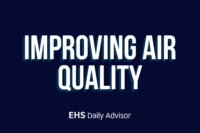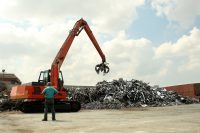Safety is a process, and as such, needs to be managed. This section offers resources to create a viable safety program, sell it to senior management, train supervisors and employees in using it, and then track and report your progress. Look also for ways to advance your own skills in these areas, both for your current job, and those that follow.
Understaffing at the California Division of Occupational Safety and Health (Cal/OSHA) has limited the state agency’s ability to perform on-site inspections, a July 17 report from the California State Auditor revealed. The auditor also concluded that Cal/OSHA didn’t provide adequate reasons for closing workplace complaints and accidents without performing an on-site inspection. The auditor’s office […]
On episode 260 of EHS On Tap, Kristi Hames, chemical safety expert and certified industrial hygienist at VelocityEHS, talks about a federal proposal to shut down the agency that investigates industrial chemical accidents.
Industrial personal protective equipment (PPE) has undergone a remarkable evolution in recent decades, transitioning from basic protective gear to sophisticated, essential equipment that does more than just sit on one’s head. Helmets, safety harnesses, and clothing have evolved into interconnected systems capable of real-time monitoring, data collection, and predictive analytics. Today’s PPE landscape is transforming […]
After initially requesting abeyance in Texas Chemistry Council, et al. v. EPA litigation over its 2024 final risk management rule regulating chrysotile asbestos under the Toxic Substances Control Act (TSCA) on July 7, 2025, the EPA withdrew that motion and “and requested that the court set an August 8, 2025, deadline for filing motions to […]
Ventilation includes the introduction of outdoor air, indoor air movement, and dilution of germs through mechanical air or nonmechanical means. Here’s what you need to know about improving air quality.
Brazilian Stone Design LLC, a Powder Springs, Georgia, stone countertop manufacturer, faces $33,000 in Occupational Safety and Health Administration (OSHA) fines for exposing workers to respirable crystalline silica, the agency announced July 10. OSHA cited the employer, which fabricates and sells kitchen and bathroom countertops, with seven serious violations. According to the agency, the employer allegedly […]
The Occupational Safety and Health Administration (OSHA) has updated its guidance on penalty and debt collection procedures in the Field Operations Manual (FOM), the agency announced July 14. The agency said the updates would minimize the burden on small businesses and increase prompt hazard abatement. “All employers should be offered the opportunity to comply with regulations […]
The Occupational Safety and Health Administration (OSHA) continues to carry out inspections and issue citations to employers that expose workers to hazardous conditions. We’ve summarized some of the key enforcement cases from the past few months for a look at where OSHA is focusing its efforts. Metal components manufacturer faces $65K in fines A Pennsylvania […]
Back to Basics is a weekly feature that highlights important but possibly overlooked information that any EHS professional should know. This week, we examine how to manage worker fatigue. Workers face many hazards on the job, but one of the most overlooked may be fatigue. Worker fatigue increases the risk for illnesses and injuries and […]
The National Safety Council (NSC), in partnership with the NCCCO Foundation, has published “Addressing Heat Stress in the Crane Industry,” a new report that aims to help employers combat heat-related injuries and illnesses, the group announced July 3. The report, published through the NSC’s Work to Zero initiative, offers targeted recommendations to protect crane workers […]










